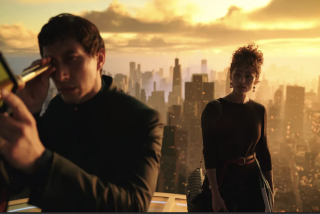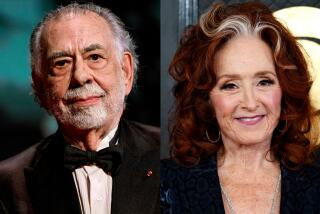The memoirist of the Coppola clan
RUTHERFORD, Calif. -- Eleanor Coppola doesn’t consider herself a writer, yet she frequently records her thoughts and observations, a writer’s habit if there ever was one. Her practice, which she admits is catch-as-catch-can, began on the set of “Apocalypse Now,” husband Francis Ford Coppola’s difficult masterwork that kept them in the Philippines for three years in the late ‘70s. Her extensive notes for “Hearts of Darkness,” an acclaimed documentary on the making of the film, became “Notes on the Making of ‘Apocalypse Now,’ ” published in 1979 and also well-regarded.
Now, Coppola has published “Notes on a Life,” her second set of observations jotted down in notebooks in the odd moments. The book covers the period roughly from the mid-’80s to 2005, with occasional dips in the further past.
“Notes on a Life,” Coppola said in an interview at her home, “doesn’t have a specific projection or underpinning, but it’s reflective of the way we think. In the present time, we are aware of something, but maybe it reminds us of something else and then we’re in the past and then we’re back to the present again. . . . As I looked back on the notes, I could see strong themes emerging, repeating themselves, certain images or ideas.”
The result is a free-flowing document that draws power from a steady accumulation of detail rendered in quiet, natural prose. It’s the testament of a woman devoted to her family, seemingly at the disservice of her own artistic goals. But it’s also not that simple.
Radiating a kind of serenity that was clearly hard-earned, Coppola, 72, often found a way, on the far-flung locations of her husband’s work, to reinforce her own creative impulses or at least operate as a key emissary. She set up makeshift homes in Thailand, France and Washington, D.C., comforted and encouraged Francis and, later, her filmmaking offspring, Sofia and Roman. The specter of the accidental death of her oldest son, Gian-Carlo or Gio, in 1986 colors the book with grief and a heightened appreciation for what she still has.
The Coppola home is a dramatic, egg-cream-colored Victorian set near rolling hills and rows of grapevines for the Rubicon Estate winery next door. In “Notes on a Life,” Coppola is always yearning to get back to the land that the couple bought in the ‘70s with a payment from “The Godfather.”
--
‘Comfortable’ place
“This place is part of my nature,” Coppola said, seated in a chair on the wraparound porch. Her mellow-blond hair was cut short and she wore dark clothes, a silver necklace. “It’s where I’m most comfortable.” Beyond the grapevines, there’s her studio, a converted barn where she works on watercolors and sketches near an altar she built with seashells for her elderly mother.
Several sets of tables and chairs were spaced out on the porch, along with a pingpong table that was apparently the center of action at a recent soiree of Sofia’s. Coppola’s birthday was coming up that weekend, and she planned to host a group of female friends for lunch. Francis is not home at the moment; he is shooting “Tetro” in Argentina, about the rivalries, suitably enough, within an artistic Italian family.
Coppola doesn’t have a writing routine; she waits until she feels a certain hunger. “I write as if I have a friend who I want to tell something to that I just experienced or thought about or was intrigued by. . . . I keep a little notebook in my purse for conversations I overhear or what people tell me. I was at the manicurist recently and she was having a life crisis and I ended up becoming her therapist. Everything she told me was just this nitty-gritty stuff of life.”
Untouched by cosmetic surgery, Coppola has the kind of wise, age-softened face and patient demeanor made for confession, weeping or ranting. It’s obvious she can take it and perhaps she’s gotten better at it over the years.
--
‘Rocky points’
In a passage in “Notes on a Life,” Eleanor describes how Francis, at near breaking point from the making of “The Godfather: Part III,” unleashes a litany of complaints. “He spoke so convincingly about all the things wrong in his life: how he hated that he was doing the same thing again that he had done nearly 20 years ago . . . he talked about his family, he complained about me. I sat there while he ran it all out. . . . I went for a walk outside. I tried to visualize all his dark words draining out of me, dripping off the ends of my fingers and running out my toes through my shoes.”
That is not to suggest that Coppola only sponged up Francis’ complaints and aired none of her own. In “Notes on the Making of Apocalypse Now,” she states that Francis and she fought for several days, concluding that they should get a divorce, a notion that unraveled moments later. In “Notes on a Life,” she drops in such lines as “when our marriage almost ended” but doesn’t go into much detail.
“I think every marriage has had its rocky points, especially if you’re these dynamic opposites,” she said. “Francis is more volatile, operatic and Italian in personality. And I’m more calm, not without emotion, but generally I’m in a calmer state. In recent years, for quite a few years now, those rocky points have been past and we’ve come out the other side.”
Conflicting personalities in marriage are something readers can relate to, including the editor of both of Coppola’s books, Nan Talese, who is married to writer Gay Talese. “Gay is very different from Francis, but there are similarities. . . . For women particularly, they will find themselves in the book because of the balance between work and family life, relationships and their own aspirations. Eleanor is amazingly honest and open.”
Coppola is also aware of boundaries, of where her story ends and others begin. Sofia’s experience with critical reviews for her performance in “The Godfather: Part III” is acknowledged but not indulged.
Looking back, Coppola acknowledges the pangs of jealousy she felt with other family members’ successes, the resentment that burned in her for often being tasked with the least glamorous aspect of making films, but it’s a muted observation now, distanced by time and acceptance of both herself and Francis and their path.
Coppola’s father, who trained as an artist in France and worked in Mexico, was a political cartoonist for the Los Angeles Examiner. He died when she was 10, but she clearly inherited some of his wanderlust, as well as her mother Eleanor Jessie Neil’s love of books and travel.
In line to be the old maid of her group of friends, Coppola met Francis in Ireland in 1963. She was working as an assistant to the art director on Francis’ horror film “Dementia 13.”
“I never expected Francis to be a celebrity when we got married. He was making [“Dementia 13”], this black-and-white film, very low budget. I thought we were going to live in the Valley,” she said with a smile. “I was just as startled and unprepared for how our lives evolved. . . . I really feel very strongly that he should be whatever he wants to be. That’s why I could always be supportive of his projects, because I felt like this is artwork and he wants to make it as much as I want to make mine.”
--
Inner adventures
There is also the realization that she did make art in that period but that the scope wasn’t limited to documentaries or the gallery; her biggest project was family. These days, her art has expanded beyond that life work.
One of the themes of “Notes on a Life” is Coppola’s grief and healing over the loss of her son Gio, an aspiring director. At the time of his death, his relationship with his mother was at a turning point. On Mother’s Day 1986, the last day she saw him alive, she writes, “I felt as if Gio was trying to make up for the hard times he has given me since his teenage years. This past six months he has changed.” He’s “happy and more self-confident and has grown closer to me.”
Coppola, who considers herself spiritual but not “a joiner of religions, per se,” has poured much of her pain and enlightenment into Circle of Memory, an installation that asks visitors to write down -- on scraps of paper -- memorials to people they have lost, a form of writing that echoes Coppola’s own efforts. The installation has traveled extensively, and it’ll arrive in Salzburg, Austria, this summer.
In the meantime, she is busy. “I was just in Argentina shooting some documentary footage for the film Francis is working on now. I have ongoing work and projects in my studio here,” she said, looking toward the barn. “Art is hard work. Everyone thinks you’re just having fun in your studio, but that’s where you face your inner demons, all your issues, but I’m drawn to it. I feel like the inner adventure is one of the great adventures.”
More to Read
Sign up for our Book Club newsletter
Get the latest news, events and more from the Los Angeles Times Book Club, and help us get L.A. reading and talking.
You may occasionally receive promotional content from the Los Angeles Times.







